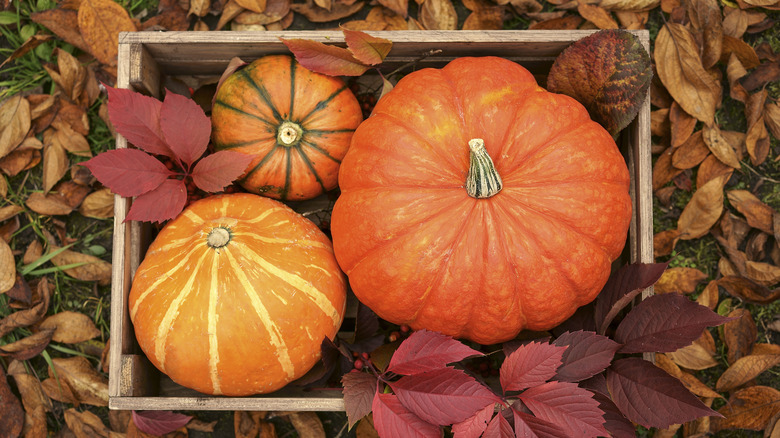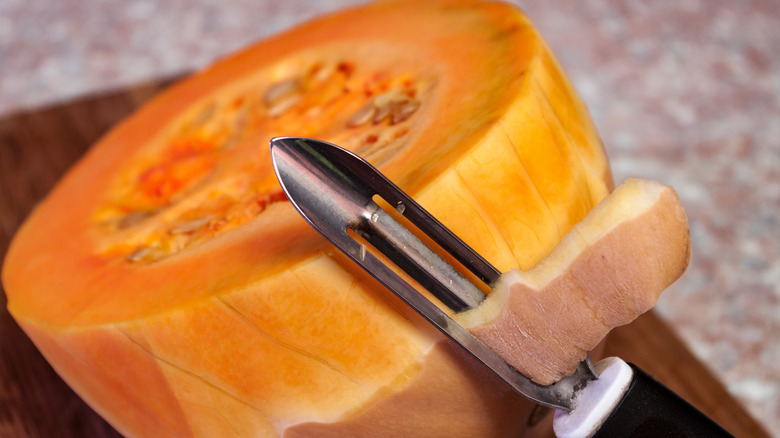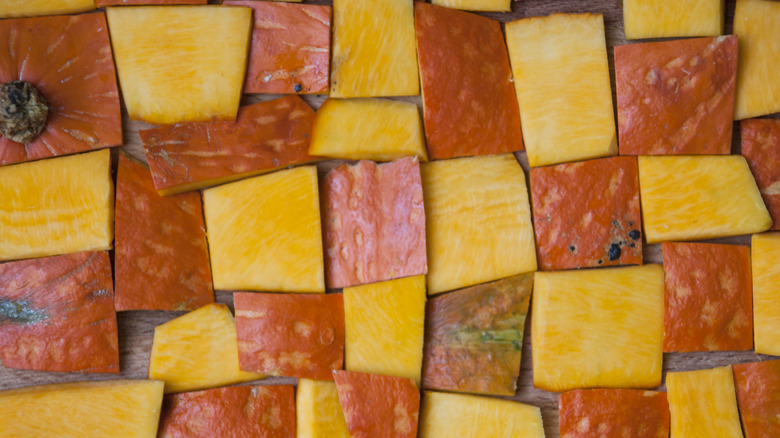Is Pumpkin Skin Edible?
Most folks know that pumpkin seeds are edible. But ask someone if you can eat the skin of everyone's favorite fall squash, and you'll probably get head scratches and confused looks. Can you eat pumpkin skin?
Yes, pumpkin skins are edible. Actually, most of the produce you'll find in the grocery store has edible skin. But just because you can doesn't necessarily mean you should. While some people can eat mango skins without a problem, many can't: the skins contain the same allergen as poison ivy. The skin of butternut squash is too tough to eat, no matter how you roast, boil, or purée it. And while you can eat pineapple skin, it's pretty clear why you wouldn't want to. On the other hand, some skins, like peaches and potatoes, are fan favorites.
While pumpkin skins are pretty tough, they're still tasty when prepared the right way. They add texture to roast pumpkin and they're also incredibly nutritious. Pumpkin is already considered a superfood, and pumpkin skins pack even more nutrients than the flesh. Just remember to wash it like any other fruit or vegetable.
That said, not everyone can benefit from eating pumpkin skins. The Crohn's and Colitis Foundation notes that people with inflammatory bowel diseases should avoid eating foods with tough peels. Getting nutrients through vegetable stock is recommended, though, and boiling pumpkin skins into stock is a great way to use them up — even if you're not worried about your diet.
How to use pumpkin skins
So you're ready to experiment with some fun new ways to cook pumpkins. Where do you start? If you want to keep it simple, leave the pumpkin skins when you roast seasoned slices in the oven, though you should use a softer-skinned variety, like Delica.
Boiling the skins can help soften tougher varieties, so soups are a great way to go. Pumpkin curry is a perpetual hit, and skins help add an extra dimension to the texture. Ready to double down? Serve your stews in hollowed-out pumpkins baked whole for a festive twist on bread bowls.
Calabaza en Tacha, a candied pumpkin dish popular in Mexico, incorporates the skins. The pumpkins are baked in a syrup made from spices and piloncillo, or unrefined cane sugar. Mexican cooks typically use a variety called Calabaza de Castilla, but you can use pie pumpkins instead.
Most recipes for mashed or puréed pumpkin tell you to remove the skins. Keep them on if you want to incorporate those extra nutrients, but be prepared for a slightly lumpy purée. Consider taking the skins off and using them separately.
Once you've removed the skins, you can roast them or turn them into pumpkin chips. Toss them in oil and season them with salt or spices, then bake them or cook them in an air fryer. They're an extra-nutritious alternative to potato chips. Still can't stand the thought of eating peels? Sprinkle pumpkin skins with spices before drying them for seasonal potpourri.
What is the nutritional value of pumpkin skins?
One perk of eating peels? Fruit and vegetable peels are typically more nutritious than the actual fruit. Pumpkin skins are no exception: they're rich in vitamin B6, vitamin E, vitamin C, potassium, iron, and magnesium. Pumpkins are also one of the best sources for lutein and zeaxanthin, two extra-powerful antioxidants. The vitamins and minerals in pumpkins can help boost your immune system, reduce inflammation, and improve your heart health. Nutrients found in pumpkins may even help protect your eyesight and reduce your risk of cancer.
Those skins can benefit your skin, too. That vitamin C helps produce collagen, which helps your skin stay healthy and plump. Pumpkin skins are also rich in beta-carotene. Beta-carotene may help support eye health and cognitive function. But it also transforms into vitamin A, also known as retinol — everyone's favorite anti-aging skincare ingredient. A 2021 scientific review suggested that, when taken orally, beta-carotene could help improve your skin texture and even boost its resistance to UV rays.
Just don't overdo it, especially if you have light skin. Beta-carotene is what gives pumpkins, oranges, and sweet potatoes their color. While moderate amounts can give you a ruddy glow, a whole patch worth of pumpkin skins could leave you looking like a pumpkin yourself.


